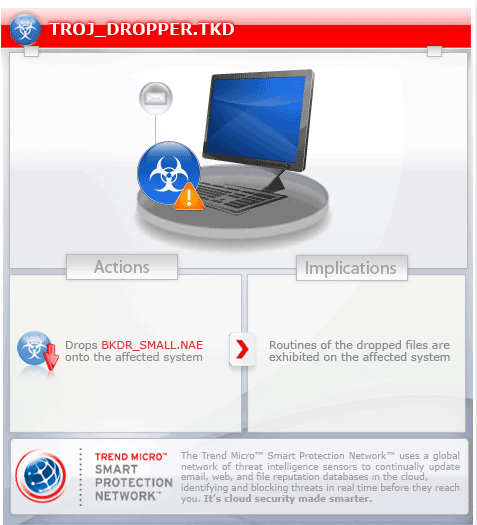TROJ_DROPPER.TKD
Windows 2000, Windows XP, Windows Server 2003


Threat Type: Trojan
Destructiveness: No
Encrypted: No
In the wild: Yes
OVERVIEW
This Trojan is related to a possible targeted attack.
To get a one-glance comprehensive view of the behavior of this Trojan, refer to the Threat Diagram shown below.

It uses legitimate program files in its attachments in order to hide its malicious routines.
This Trojan arrives as an attachment to email messages spammed by other malware/grayware or malicious users.
It executes the files it drops, prompting the affected system to exhibit the malicious routines they contain.
TECHNICAL DETAILS
61,440 bytes
EXE
No
02 Sep 2011
Drops files
Arrival Details
This Trojan arrives as an attachment to email messages spammed by other malware/grayware or malicious users.
Installation
This Trojan drops the following files:
- %User Profile%Application Data\Locations\winhlps.exe - detected as BKDR_SMALL.NAE
(Note: %User Profile% is the current user's profile folder, which is usually C:\Windows\Profiles\{user name} on Windows 98 and ME, C:\WINNT\Profiles\{user name} on Windows NT, and C:\Documents and Settings\{user name} on Windows 2000, XP, and Server 2003.)
It drops the following non-malicious file:
- %User Temp%\{random}.doc
(Note: %User Temp% is the current user's Temp folder, which is usually C:\Documents and Settings\{user name}\Local Settings\Temp on Windows 2000, XP, and Server 2003.)
It creates the following folders:
- %User Profile%Application Data\Locations
(Note: %User Profile% is the current user's profile folder, which is usually C:\Windows\Profiles\{user name} on Windows 98 and ME, C:\WINNT\Profiles\{user name} on Windows NT, and C:\Documents and Settings\{user name} on Windows 2000, XP, and Server 2003.)
Dropping Routine
This Trojan executes the files it drops, prompting the affected system to exhibit the malicious routines they contain.
NOTES:
It drops a non-malicious Microsoft Word document in order to mask the malicious routines it performs.
SOLUTION
9.200
8.396.08
02 Sep 2011
8.397.00
03 Sep 2011
Step 1
For Windows XP and Windows Server 2003 users, before doing any scans, please make sure you disable System Restore to allow full scanning of your computer.
Step 3
Search and delete these folders
- %User Profile%Application Data\Locations
Step 4
Scan your computer with your Trend Micro product to delete files detected as TROJ_DROPPER.TKD. If the detected files have already been cleaned, deleted, or quarantined by your Trend Micro product, no further step is required. You may opt to simply delete the quarantined files. Please check this Knowledge Base page for more information.
Did this description help? Tell us how we did.

